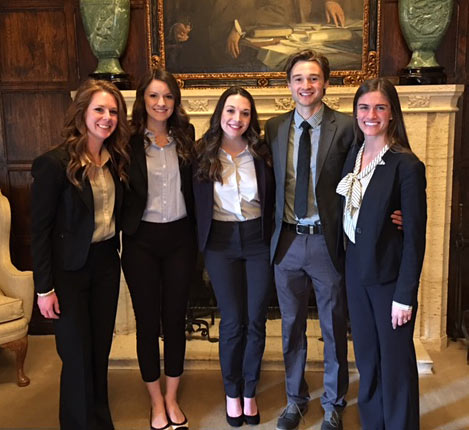Students present experiential research project findings at Mayo Clinic
March 23, 2017
By Michael Hemmesch '97

Left to right: Hannah Goossens ‘12, Isabel McKeown, Haylie McClung, Brady Riesgraf, Kaitlin Duda
Four students at the College of Saint Benedict and Saint John’s University recently concluded their work in the Mayo Innovation Scholars Program (MISP).
CSB senior global business leadership and Hispanic studies major Kaitlin Duda (Eden Prairie, Minnesota), CSB junior integrative health science major Haylie McClung (East Bethel, Minnesota), CSB junior global business leadership major Isabel McKeown (Stillwater, Minnesota) and SJU senior biology major Brady Riesgraf (Chaska, Minnesota) presented project research on “Minimally Invasive Atresia Repair Device.”
The interdisciplinary program provides research opportunities to teams of undergraduates from Minnesota private colleges, under the guidance of select master’s-level business students. Students in this collaborative program work at the interface of science, medicine and business. Through teamwork, they learn the practical aspects involved in bringing an idea to the marketplace.
The CSB and SJU students worked as a team on the project on campus throughout the 2016-17 academic year. They presented their findings in March at Mayo Clinic in Rochester, Minnesota, and in a written report. On average, each student put in roughly 175 hours of work during the program.
Support and praise from advisors
The students were supported by Hannah Goossens, a 2012 CSB alumna and current MBA student at the University of St. Thomas. CSB and SJU faculty members Lisa Lindgren, associate professor of global business leadership, and Jennifer Schaefer, associate professor of biology, served as project advisers. Laura Hammond, assistant director of experiential learning and community engagement at CSB and SJU, provided administrative support.
“The students are so proud when they master a very complex subject and provide meaningful recommendations to Mayo,” Lindgren said. “This year, the students were so excited that the inventor of the device was in the audience and provided very positive feedback on their work.”
“It is so crucial for students to be able to thrive in a cross-functional team environment and to learn to put structure around ambiguity, and this project is the perfect landscape for that,” Goossens said. “It is an incredible opportunity to work with such a renowned brand as Mayo Clinic and to apply research and learning to a real-world project in the science and business industries.”
Now in its 11th year, MISP aims to assist high-achieving students from private colleges in Minnesota gain real-life experience of innovation and commercialization under the auspices of Mayo Clinic Ventures. The students help in the assessment of new products submitted by Mayo researchers.
The program was designed in 2006 by John Meslow, a retired Medtronic executive. Together with Mayo Clinic Ventures and the Minnesota Private College Council (MPCC), Meslow created an innovative model for student experiential learning.
Mayo Clinic staff members and program administrators were impressed by the quality of the students' work, including the project’s inventor.
In total, there were 11 presentations over two days by MPCC member institutions.
